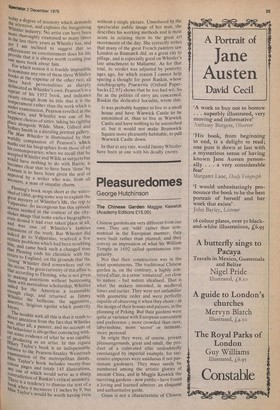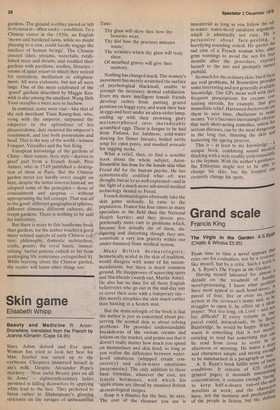Pleasuredomes
George Hutchinson
The Chinese Garden Maggie Keswick (Academy Editions .£15.00) Chinese gardens are very different from our own. They are 'wild' rather than symmetrical in the European manner; they were built rather than planted; and they convey an impression of what Sir William Temple in 1692 calledspontaneous irregularity. Not that their construction was in the least spontaneous. The traditional Chinese garden is, on the contrary, a highly contrived affair, in a sense 'unnatural', yet close to nature — but nature idealised. That is what the makers intended, in medieval times and earlier. They were not unfamiliar with geometric order and were perfectly capable of observing it when they chose — in the design of their houses and palaces, in the planning of Peking. But their gardens were quite at variance with European convention and preference -T more crowded than ours, labyrinthine, more 'secret' or intimate, more personal. In origin they were, of course, private pleasuregrounds, great and small, the product of a cultivated elite undoubtedly encouraged by imperial example, for suc cessive emperors were assiduous if not passionate gardeners. They must surely be numbered among the artistic glories of ancient China, and in Maggie Keswick the 'surviving gardens— now public— have found a loving and learned admirer, an eloquent and authoritative guide. Grass is not a characteristic of Chinese gardens. The ground is either paved or left in its natural often rocky -condition. To a Chinese visitor in the 1920s, an English 'mown and bordered lawn, while no doubt pleasing to a cow, could hardly engage the intellect of human beings'. The Chinese created lakes, streams, waterfalls, established trees and shrubs, and studded their gardens with pavilions, studios, libraries rooms of quiet resort to which they retired for recreation, meditation or enlightenment. All were elaborate, but not all were large. One of the most celebrated of the 'grand' gardens described by Maggie Keswick is also among the smallest: Wang Shih Yuan occupies a mere acre in Suchow.
In contrast, some were vast like that of the rich merchant Yuan Kuang-han, who, vying with the emperor, surpassed the emperor in the splendour of his pleasuredome, duly incurred the emperor's resentment, and lost both possessions and head. That is the way of the world witness Fouquet, Versailles and the Sun King.
European knowledge of the gardens of China their nature, their style derives in great' part from a French Jesuit, Pere Attiret, who in 1749 published a description of them in Paris. But the Chinese garden never (or hardly ever) caught on here, despite the initial interest.Instead, we adopted some of the principles those of concealment and surprise without appropriating the full concept. That was all' to the good: different geographical spheres, different climates, different cultures, different gardens. There is nothing to be said for Uniformity.
But there is more to this handsome book than gardens, for the author touches a good many related aspects of early Chinese culture: philosophy, domestic architecture, crafts, poetry, the royal hunts, 'immortalising' herbal potions (which so far from prolonging life sometimes extinguished it). While learning about the Chinese garden, the reader will learn other things too.







































 Previous page
Previous page